Early the next morning I headed for Cusco. Although there is also a possibility to take a train here, I had decided to opt for a coach, as that type of transportation was a combination between an inter-city line and a sightseeing tour. We made a couple of breaks along the way that provided us with just the right amount of time for short visits to the places in which we stopped. At one point, we could see the peak of mountain Khunurana with a glacier from which the river Vilcanota springs. In its lower course the Vilcanota is called Urubamba. This is precisely the river along the valley of which one reaches Machu Picchu. Mountain Khunurana also marks the departure from the Altiplano and moving to the region of Cusco which generally has a milder climate.
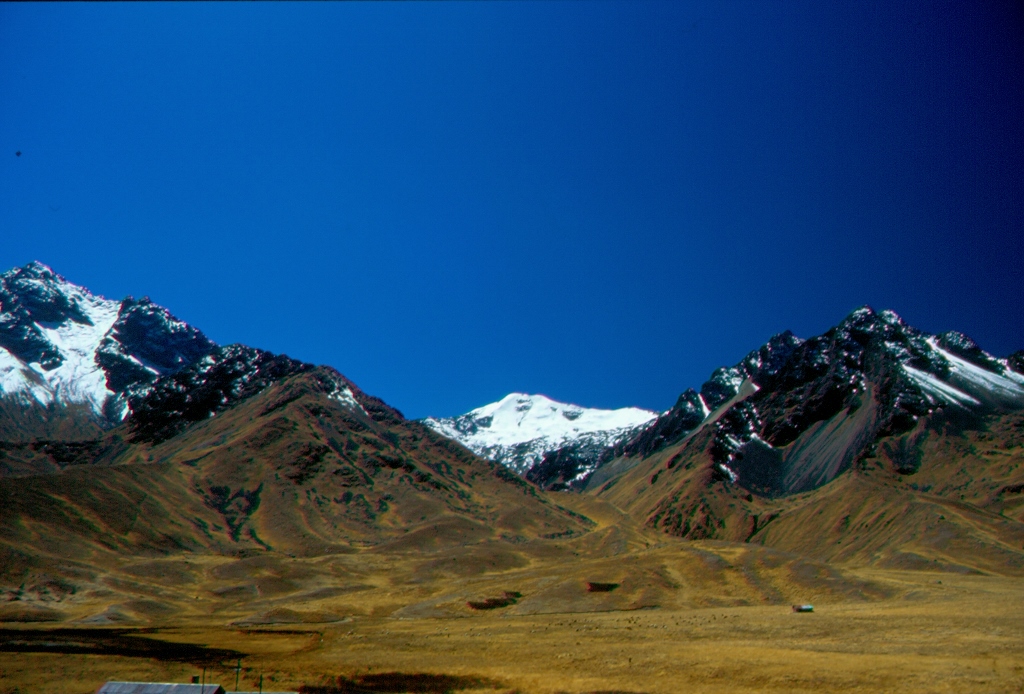 Mountain Khunurana
Mountain Khunurana
This, of course, doesn’t mean that the altitude is automatically much lower. Cusco is situated at 3,399 m above sea level and that can constitute a serious problem for people who fly here from Lima. Namely, Lima is at the level of the ocean and the abrupt passage to these heights can cause health problems. People are usually advised to lie down and rest as much as possible on the first day when they arrive in Cusco in order to give the organism a chance to adapt gradually to the lack of oxygen in the air. Obviously, this is often not possible for tourists who arrive here just for a couple of days.
In Cusco I was greeted by Pepe. This was a son of Virginia’s colleague and I had already been given his email, so the two of us established a contact in the meantime. He offered me to stay at his place, since he had a guest room, and this was how we agreed. When we went to his house, I first explained to him what I wanted to see and what my further plans were, as he had his own tourist agency. Eventually we agreed that he should organize both the train ticket to Aguas Calientes and a plane ticket to Lima for me. He couldn’t arrange it that same evening, so we agreed he would do it the day after.
When I woke up the next morning, Pepe had already gone to work, and I slowly got ready and went to a nearby internet cafe. A little later I spoke with my host on the phone and since he confirmed that everything had been organized, I leisurely went to visit Cusco.
First I took a taxi to the fortress Sacsayhuaman. This is a very interesting site, to say the least. Generally speaking, all Inca settlements had the shape of a puma, a condor, a snake or a llama, as their holy animals. Inca’s Cusco had the shape of a puma and it is considered that the zigzag walls of this fortress represented in fact the teeth of the puma that faced outside the city thus protecting it. The walls are arranged in three rows. They are made of huge stones, but even such big rocks are perfectly fitted, which was a building speciality of the Incas. The stones were not processed in regular shapes. Quite the contrary, they are mostly of irregular shapes, but this was still ideally fitted without any bonding material.
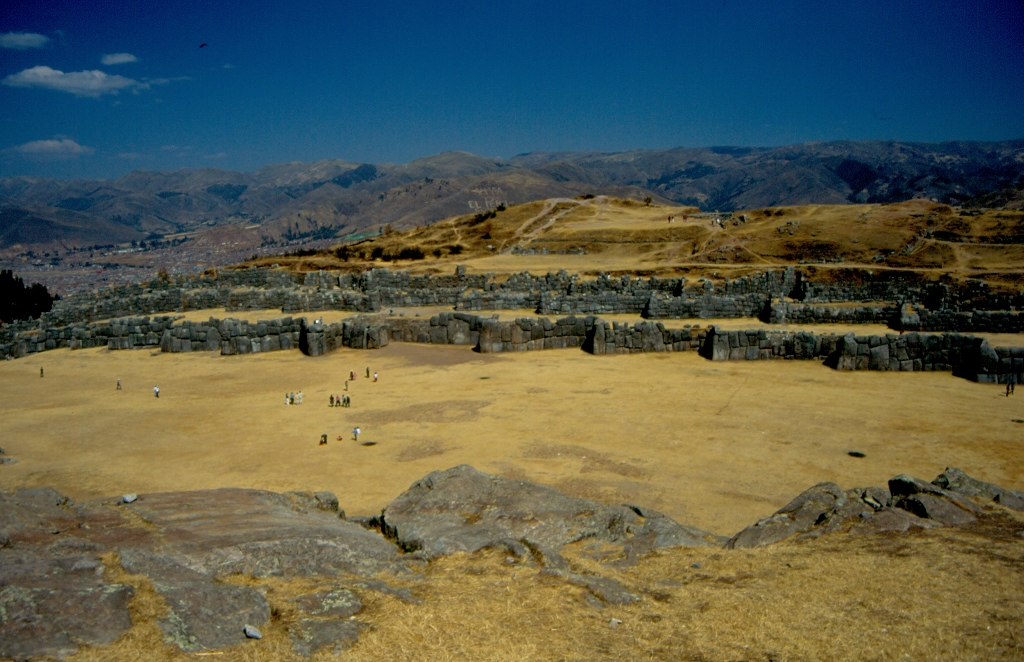 Sacsayhuaman, to the top and left it is possible to see Cusco at the foot of the elevation
Sacsayhuaman, to the top and left it is possible to see Cusco at the foot of the elevation
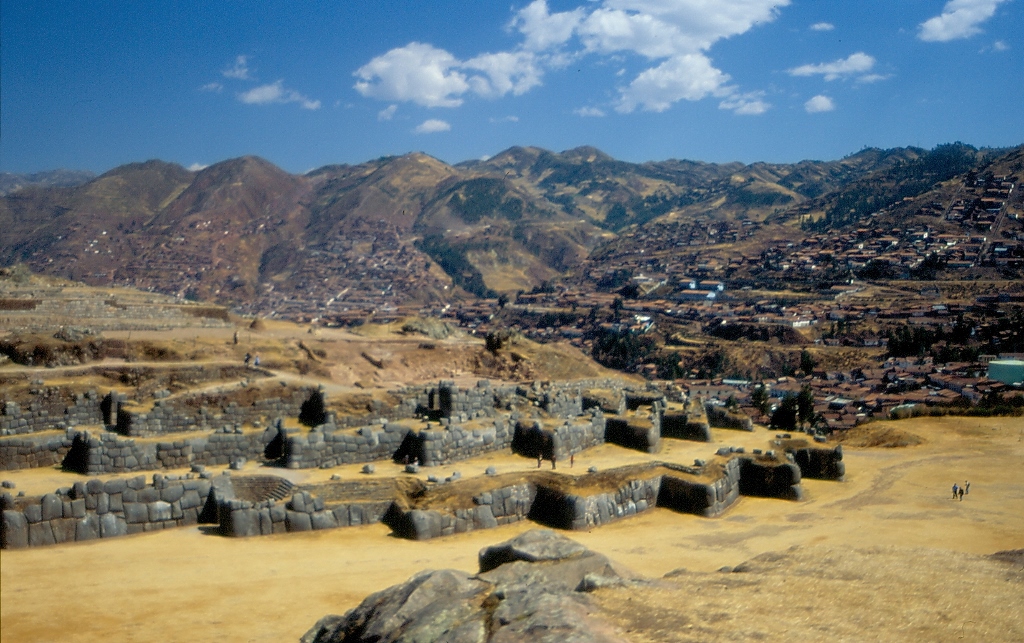 Sacsayhuaman and the surrounding settlements
Sacsayhuaman and the surrounding settlements
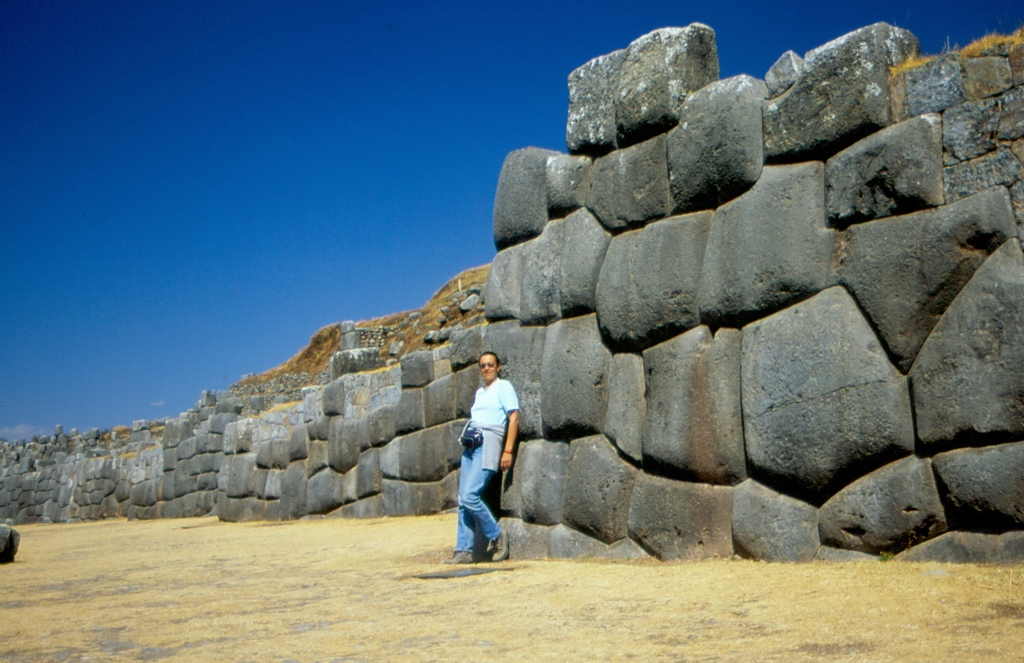 Sacsayhuaman: Technique of building stone walls the Inca way
Sacsayhuaman: Technique of building stone walls the Inca way
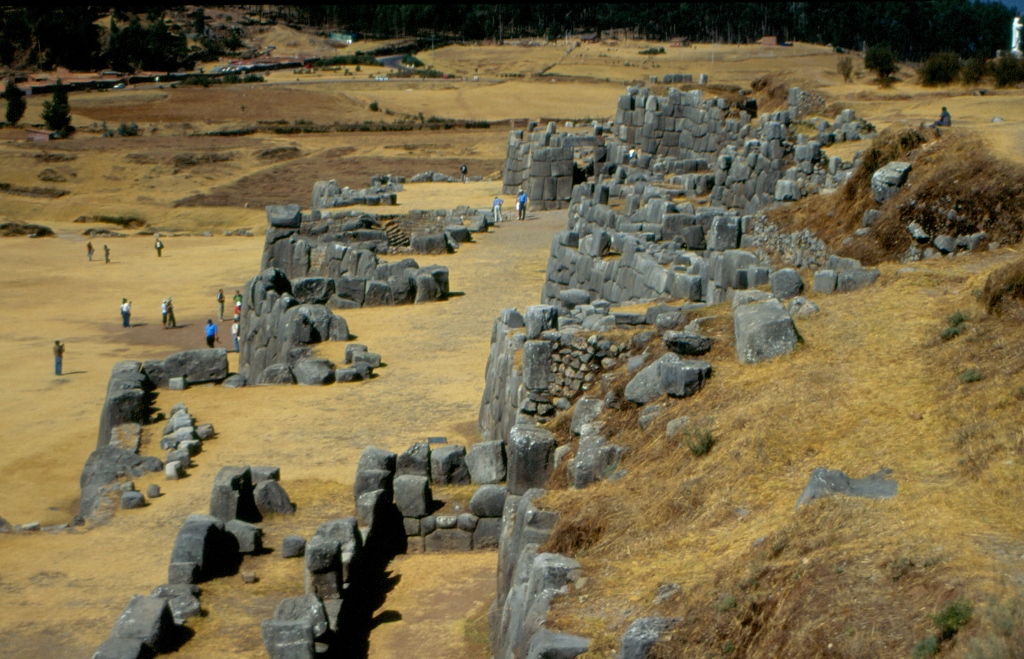 Sacsayhuaman: three rows of stone “teeth”
Sacsayhuaman: three rows of stone “teeth”
By the way, this fortress played a very important role in the first half of the 16th century after the Spaniards had arrived. At one point, the Incas rebelled under the leadership of Manco Inca and their base was precisely within the Sacsayhuaman fortress. For several days there was a lot of to and fro, and the Incas even had a serious chance to overcome the Spanish, but the latter managed to get the upper hand and the rest we know. If the Incas had won then, they may have regained their territories. Admittedly, I don’t think the things would have changed much in the long run, as the wheel of history was already set in motion that was not in favour of the local population, but in this case at least the history of these areas would not have been so one-directional.
Nowadays, although they are impressive, the fortifications are still rather limited. Other than the walls themselves, there is not much else to see, although when one goes to the highest part of the site, there is a wonderful view of Cusco.
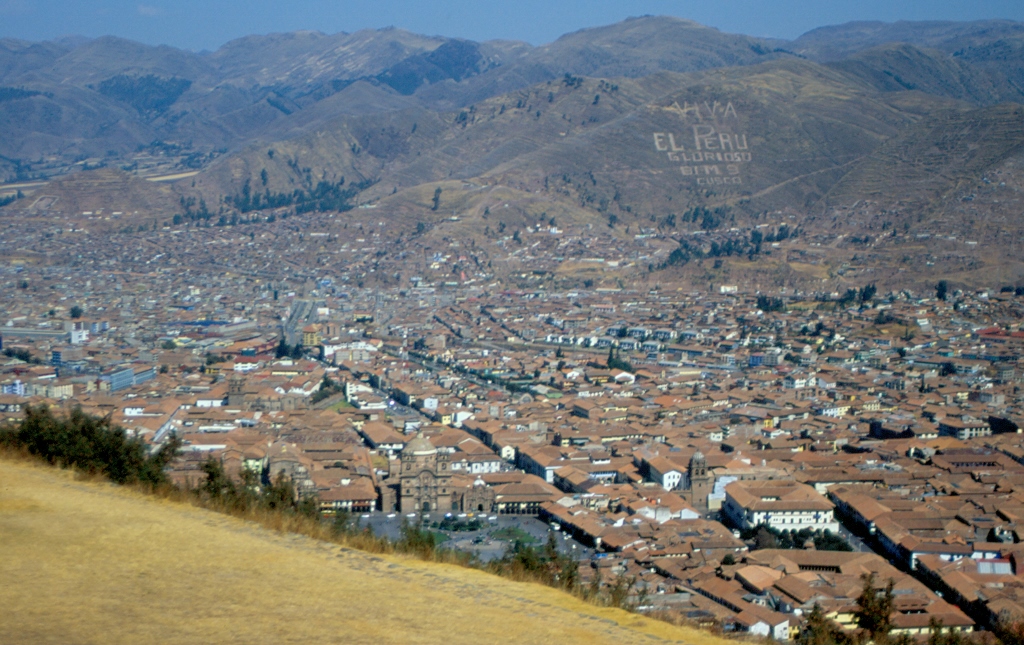 Cusco
Cusco
After I had finished visiting the site, I walked down directly to the centre of Cusco and from there started to visit the town. In addition to the Cathedral, the main square called Plaza de Armas also contains a beautiful church of La Compañia de Jesus.
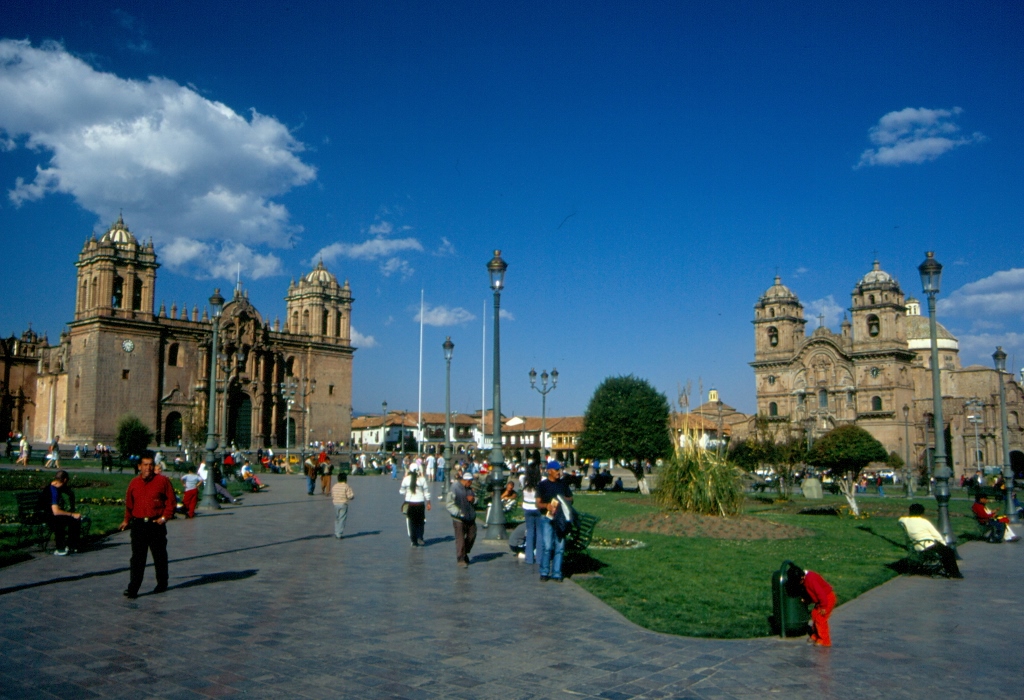 Plaza de Armas, the main square in Cusco. The Cathedral is to the left and the church of La Compañia de Jesus is to the right.
Plaza de Armas, the main square in Cusco. The Cathedral is to the left and the church of La Compañia de Jesus is to the right.
In fact, the entire Cusco is an exceptionally beautiful town that consists of numerous buildings from the period after the Spanish conquest, with a number of lovely squares and a myriad of narrow streets. It was while walking along some of these streets that it was possible to see the masonry difference between the Incas and the Spanish. Namely, a good deal of the buildings that can be seen today have been erected on top of the remains of the buildings that used to belong to the Incas. In some cases, the outside walls that face the street are not covered by plaster and along the bottom it is possible to see the remains of the walls made by the Incas – perfectly fitted stones, while above or in between there is what the Spanish did – it obviously serves the purpose, but the visual effect leaves an impression of sloppiness and the stones seem as if only haphazardly piled up. In my video materials, I’ve come across a shot of a wall that separates the street from some property, but it is an excellent illustration of what I’m talking about.
Nowadays, Cusco is primarily a tourist place and therefore there are lots of hotels and restaurants, not to mention souvenir shops. I went to the Central Market that is full of everything – fruits, vegetables, meat, cheeses and eggs, as well as household items – weaved baskets, wooden spoons, etc. There was also a lot of popcorns that can frequently be bought throughout the Andes. Usually, vendors offer them from their carts on which they have huge piles of popcorns that they put into small plastic bags when selling them to customers.
Walking around Cusco, I already started to feel sorry that I would not have more daytime to spend in it and to sit in some cafe in those gorgeous squares (Plaza Nazarenas or Plaza San Francisco) taking in all the colourful images around me. In order to see as much as possible, sitting anywhere was simply not an option and I just kept walking around Cusco. Thus I went to the church of Santo Domingo. As I approached its entrance, I saw on the stairs in front of the church a silver pendant with an image of some Inca divinity, one of those that are typically sold to tourists. It was still a daytime and there were people around me. I thought the owner would realize the pendant was lost and would retrace his or her steps or that somebody else would notice the pendant, so I proceeded and entered the church. The church of Santo Domingo is located in the place where there used to be one of the Inca palaces and it was built in the mestizo style (a mixture of the Spanish and the Andean styles). When there was an earthquake here around the mid-20th century, the walls built by the Spanish suffered a lot of damage, but the walls left from the Incas that were over 600 years old remained completely intact. After the visit to the church, I went out to the light of the day and went along the same route that I used to get into the church and there stood the silver pendant. I looked around, but nobody was approaching to take it, so I interpreted this as a sure sign that the pendant had chosen and waited just for me. I bent down, took it and today it is one of the few souvenirs I have from Peru.
When I finished with my walk around Cusco, I headed for the house of Pepe. There I had an adventure with a local dog. Generally speaking, there are a lot of dogs around Peru and Bolivia. When I say there are a lot of them in these countries, I mean to say that there are a lot of them in the streets of urban areas, as well as along the roads and completely remote areas where there seems to be no human settlement around. Still, although they appear quite abandoned, I didn’t get an impression they were dangerous. On the way from Puno to Cusco, we made a lunch break in a village. After the lunch was over, I went out and stood idly at the entrance into the restaurant. There was a dog outside. In the group I was travelling with, there were a couple of English tourists and they also stood there. The English woman bent down and took a stone as if intending to throw it at the dog, which surprised me a lot, since this was an English person and the English are generally said to be animal lovers. However, my first impression was erroneous and this woman also clearly liked animals. This was only to show to her fellow traveller that local dogs feared the motion, since the dog ran away as soon as it could just from her bending down and taking the stone into her hand. I guess the dogs are familiar with having stones thrown at them.
And so I was going back to the house of Pepe, passing through a residential part of Cusco, when all of a sudden a dog came behind me and started to bark on top of its lungs. I generally like dogs and get on well with them, but I didn’t feel comfortable in this situation. I started to be covered by cold sweat, but I bravely continued walking at the same pace. So, I go leisurely, as if it was all fine, but the dog keeps following me, barking like crazy, while I have all these thoughts in my head. What to do if it really decides to jump at me? It just kept barking and I just kept trying not to give any significance to it and to continue walking in the same rhythm. It was all in vain and the dog persisted with its snarling. Then I thought it probably sensed my fear and I decided to be proactive and to try different tactics, so I turned backwards and looked at it, mildly, but not directly in the eyes, as if showing it I was not afraid. When I did this, it pulled a little. For a moment it stopped barking and jerked backwards, but then it continued with its business. I remembered the English woman, so I turned back again, but this time as if angry, and the dog startled even more, but continued to snarl at a safe distance. At my third “angry look” it still barked, but only for a little while longer. Then it gave up on me and went in the other direction. And I felt better.